#olfactorymemoryandmourning
Explore tagged Tumblr posts
Text
Artist Statement: Olfactory Memory and Mourning (2023)
My short film, Olfactory Memory and Mourning, is a tribute to Anne-Héloïse Dautel’s digital media series Olfactory Nostalgia (2021).
Her original series articulated her experiences of parosmia (altered smell/taste) when she had Covid-19 in 2020. The series emphasises the connection between sensory experience and memory. The images below were most impactful for me.
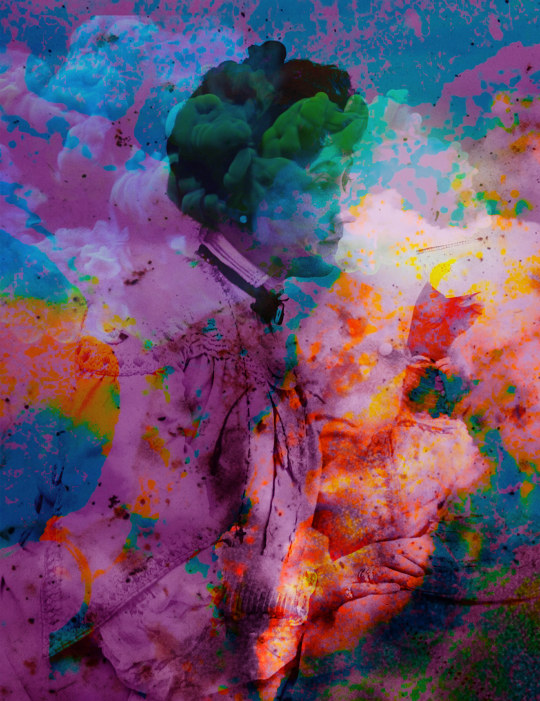
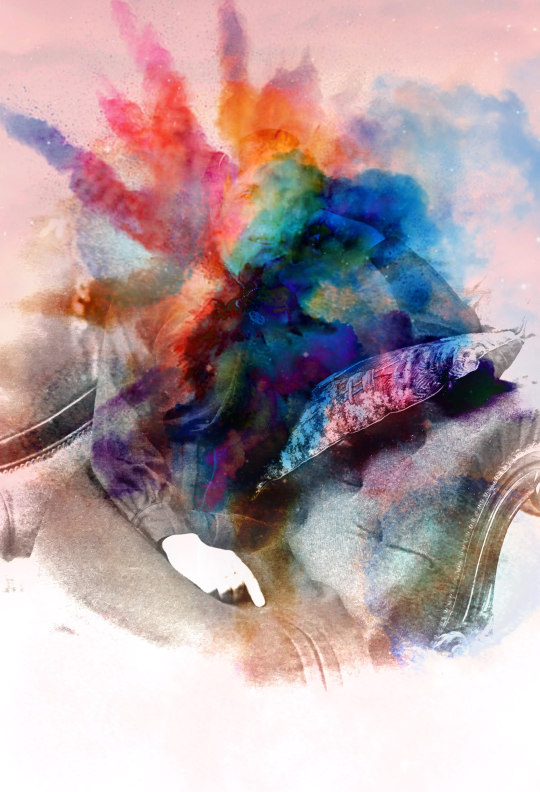
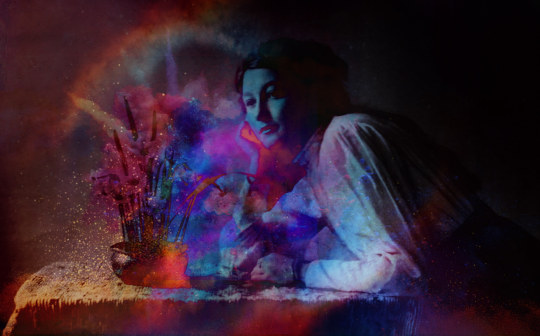
These works resonated with me as someone who contracted Covid-19 earlier this year, which resulted in anosmia, where I had little or no sense of smell or taste.
My short film aims to recontextualise Dautel’s visual choices and showcase my emotions about the olfactory impairment I experienced.
Echoing Dautel’s juxtaposition of vibrant gaseous patterns over pre-existing monochrome photographs, my process involved:
Splitting the film into three ~1-minute-long segments of footage.
Each segment has me (as the actor to establish a more personal role within the work) in a similar pose and expression (neutral) to that in the photographs but performing a different action: smelling a flower (segment 1), spraying perfume (segment 2), and eating a meal (segment 3).
Photographs, like films, carry memory – these memories can be a happy reminder of times that have since passed.
I wanted this choice to evoke a sense of nostalgia that smells can elicit and the grief and longing I felt with not being able to ‘recognise’ familiar scents or encounter new ones.
Creating a soundscape for each segment, composed of sounds recorded via a Zoom recorder.
An overarching track (sniffing and breaths) is paired with secondary tracks representing the activity depicted in the filmed segments: plants rustling and long inhalations for segment 1, perfume spraying and sharper breaths for segment 2, and boiling water and chewing for segment 3.
I’ve distorted the audio close to end of each segment, indicating a realisation of one’s inability to smell and its impact on how one experiences not just smell, but also daily life.
Producing abstract animations to act as an overlay for greyscale footage.
The animated overlays fade into greyscale when the soundtrack distorts.
These share similar overall shapes and colour palettes with Dautel’s abstract overlays, representing the diversity of smells one can experience.
I have also added some graphic elements, which nod to the olfactory tissues/nerves of different animals and Dautel’s other works.
The overlay fading to the same greyscale palette as the rest of the film aligns with the meaning of photographs I mentioned earlier: photographs can be a vessel for reminiscence and grief.
This transformation may also signify the loss of smell that anosmia causes.
The link to my full documentation is in this blog (from concept research to process): https://www.tumblr.com/aangussca
0 notes
Text
Creative exercise reflection: Using a film camera (23.2.23) and artificial lighting (16.3.23) - OLD BC IT WAS SAVED IN MY TUMBLR DRAFTS FOR A WHILE
Film Camera
The camera (Nikon?) had a microphone mounted on a metal frame.
We had a practice with capturing various shots (perhaps this could be considered in filming my short film - I have my Canon camera).
Artificial lighting
Various forms of lighting were used in production studios (with and without coloured gels).
Two-toned lighting creates a nice contrast.
Due to time restraints, both may be used for future works.
0 notes
Text
Creative exercise reflection: Improvised soundscape/soundtrack (28.2.23) - OLD BC IT WAS SAVED IN MY TUMBLR DRAFTS FOR A WHILE
Using Ableton Live and a keyboard synthesiser, each of the classmates took turns creating their own track for the creation of a composition.
Whilst my track was by no means perfect (I was happy with how it sounded though), I felt that layering various other tracks was an intriguing way to create a soundscape.
This might be something I could do with my own short film, but have it composed of sound effects that I will record.
0 notes
Text
Production log: Editing the final video (24.3.23 - 26.3.23)
Some points I need to make:
Due to Premier Pro acting up on my Adobe Creative Cloud account (which I'll ask my teacher about), I have decided to use iMovie for editing the rest of this film.
I first paired the soundtrack with each video, and then paired that with the overlay (which transitions into black and white upon audio distortions).
Further adjustments were made to the sound (fixing audio peaks from Segment 1-exclusive track), film (brightness) and overlays (opacity, brightness and colour saturation).
The film is a total of three mins and 18 secs long.
0 notes
Text
Production log: Creating the looping animations (20.3.23 - 22.3.23) (Part 3)
Segment 3:
0 notes
Text
Production log: Creating the looping animations (16.3.23 - 20.3.23) (Part 2)
Segment 2 (underneath the finalised overlay is a screencap from an older animated overlay (similarly going outwards), which will no longer be used):

0 notes
Text
Production log: Creating the looping animations (12.3.23 - 16.3.23) (Part 1)
There are two versions I've done of each animated overlay: one with a black background for the purpose of showing the different colours/opacities (shown here more clearly) and one with a white background for ease of editing.
Segment 1:
EDIT (as of 26.3.23): Opacity has been changed slightly, which will be apparent in the final work.
0 notes
Text
Production log: Editing the tracks (17.3.23)
(Tried to upload finalised tracks, edited on Ableton Live, but they are apparently too big to put on here)
0 notes
Text
Production log: Recording sounds for soundtrack (11.3.23 - 13.3.23)
I have recorded sounds for each of the segments.
I will create soundtracks out of those on Friday.
0 notes
Text
Useful stuff for Premier Pro (specific for what I want to do for my own work - from the tech class) to look at for future reference (9.3.23)
Links
How to make footage black and white: https://www.youtube.com/watch?v=poxRsaGOAHQ
How to transition footage from colour to black and white: https://www.youtube.com/watch?v=EJDjf1jjjD4
How to remove the (white) background of my animations for overlay: https://www.youtube.com/watch?v=2ntQ-QPipY4
How to change the opacity of the overlay: https://filmora.wondershare.com/video-editing/overlay-video-in-premiere-pro.html
How to edit soundtracks in Premier Pro: https://www.youtube.com/watch?v=4cg7xL7V9Z4
Keyboard shortcuts
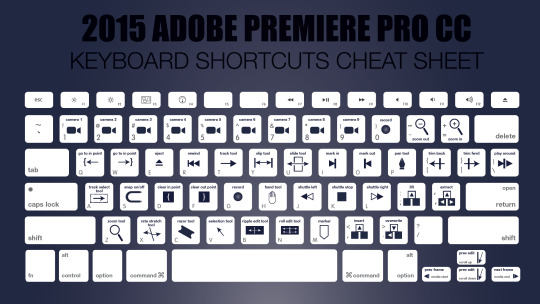
0 notes
Text
Reflective note (7.3.23): Feedback from project proposal with my tutor Robyn Backen
I have quite an illustrative style, and while that would work in the animated overlays, my initial concern was that also using it in place of the planned live footage (still greyscale - this change was suggested as a potential idea by Robyn) would make the short film deviate further away from the representative nature of Dautel’s original series.
Suggestion: Try the live footage first and if that doesn’t work, perhaps do the animation for everything.
I could easily start recording the live footage, perform my scene and edit out the beginning in post-production (alongside the conversion to greyscale, overlay, soundscape).
This will hopefully address the issue of the actor that I brought up earlier.
And most importantly, PLEASE BE REALISTIC AND TIMELY WITH EXECUTING YOUR PLANS (especially the soundscape and animated overlays).
0 notes
Text
Lecture notes: Recombinant Poetics and Art (remixing and sampling as strategies) (7.3.22)
Recombinant poetics
An umbrella term encompassing artistic approaches that challenge the traditional notions of authorship and originality.
Recontextualises and recombines existing elements in various ways, including but not limited to the:
Remixing and sampling of sound (e.g. Pierre Schaeffer’s ‘Études de bruits’ (1948) and Randall Taylor’s ’Tape Loop Orchestra (Live Ambient Cassette Loops)’ (2020 as part of his ongoing Amulets project))
Juxtaposition and layering of images/videos in a collage-like fashion (e.g. Anne Zahalka’s ‘Wild Life in the Age of Anthropocene’ series (2018))
Combining found objects (or in Hany Armanious’ case casts/copies of found objects) in sculpture in some way (e.g. Hany Armanious’ ‘Moth’ (2020))
Repetition and wordplay, emphasising rhythm and sound over any traditional narrative structure (e.g. Gertrude Stein’s ‘If I Told Him: A Completed Portrait of Picasso’ (1923))
0 notes
Text
Storyboards - no animated overlay and containing key poses (4.3.23 - 5.3.23)
Adapted segment: Olfactory Nostalgia I (rows viewed in order from left panel to right)

Adapted segment: Olfactory Nostalgia II (rows viewed in order from left panel to right)
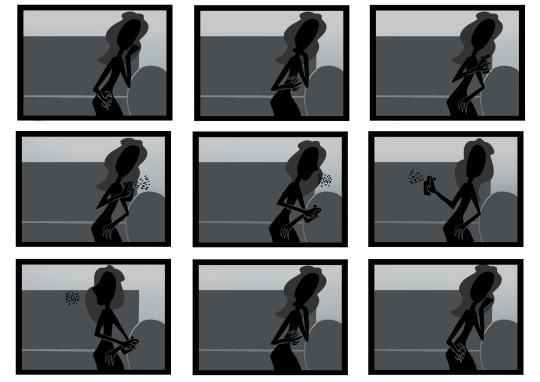
The storyboard for the adapted segment of Olfactory Nostalgia III is not available, but it follows the basic script (see previous post).
0 notes
Text
Creative exercise: Planning for project production (28.2.23 - 2.3.23)
Inventory
Props:
Peony (Olfactory Nostalgia I segment)
Perfume bottle (Olfactory Nostalgia II segment)
Sofa - should I have it (Olfactory Nostalgia II segment)
A dish cooked by me beforehand (TBD), which I will eat (Olfactory Nostalgia III segment)
Equipment and programs:
Canon EOS camera (which I already have)
Tripod (might hire from SCA)
Zoom recorder (for recording non-diegetic soundscape)
Premier pro (video and sound editing)
Costume:
White linen shirt (Olfactory Nostalgia I and III segments)
Dark linen shirt and dark (black) layered skirt (Olfactory Nostalgia II segment)
Basic Script
Short film starts with the beginning of Olfactory Nostalgia I, and ends when the Olfactory Nostalgia III segment finishes
Each segment has its own animated footage overlay, and my face will be mainly neutral throughout.
‘Fade to/from black’ transitions or sharp cuts between footage segments? (Perhaps the former)
Olfactory Nostalgia I:
Medium shot, with myself in a side-profile like the original image (beginning pose is almost completely stationary - interrupted by bringing up the peony after a few seconds).
I simply examine and smell the peony, with the film recording the action for a minute.
Olfactory Nostalgia II:
Medium shot, with myself sitting on the chair like the original image (beginning pose is almost completely stationary for a few seconds- but I’m additionally holding the perfume bottle).
I simply examine, smell and spray the perfume bottle, with the film recording the action for a minute.
Olfactory Nostalgia III:
Medium close-up shot (including the table), with myself in the pose of the original image (beginning pose is almost completely stationary for a few seconds - changing when I start eating).
I simply begin eating the dish, with the film recording the action for a minute.
Ideas for soundscape (considering Skowrońska and Van Der Eijk’s films)
Non-diegetic - as a means of articulating olfactory memory and the loss/distortion of smell.
Main track (I.e. present in all segments) is composed of (spliced) sniffing sounds (much shorter breaths), but each segment’s soundtrack will have additional tracks unique to the action taking place (TBA):
Olfactory Nostalgia I: longer inhalation and exhalation; shaking leaves/plants; natural ambience (quiet local reserve with birds, wind, etc.)
Olfactory Nostalgia II: spraying perfume; shorter exhalations; fizzing water
Olfactory Nostalgia III: boiling water (cooking); gurgling water (or some other noise to suggest swallowing/digestion); breaking apart vegetables, fruit, other food to suggest chewing
0 notes
Text
Visual Development sketches with notes (26.2.23 - 1.3.23)
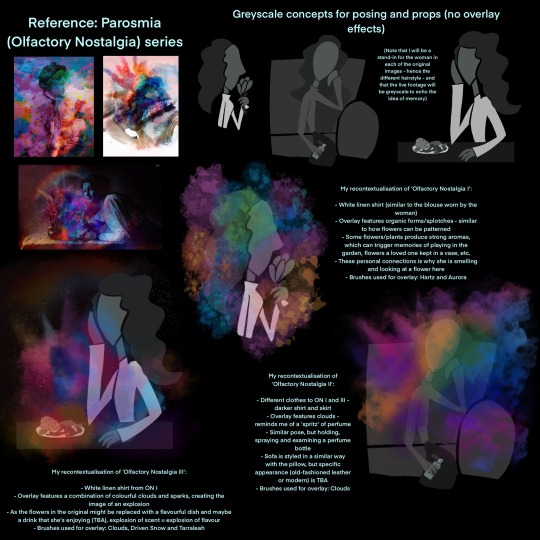
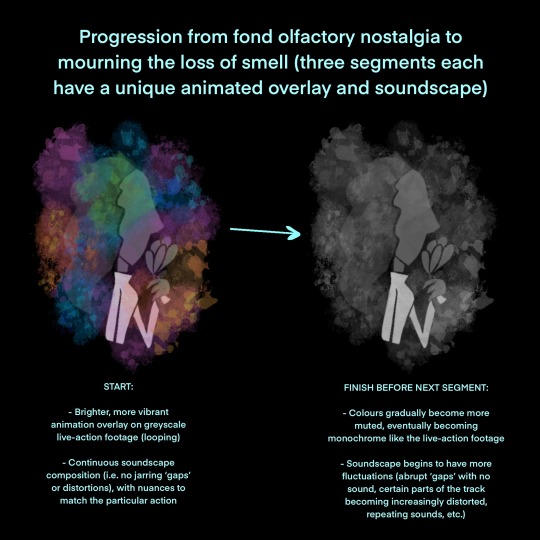
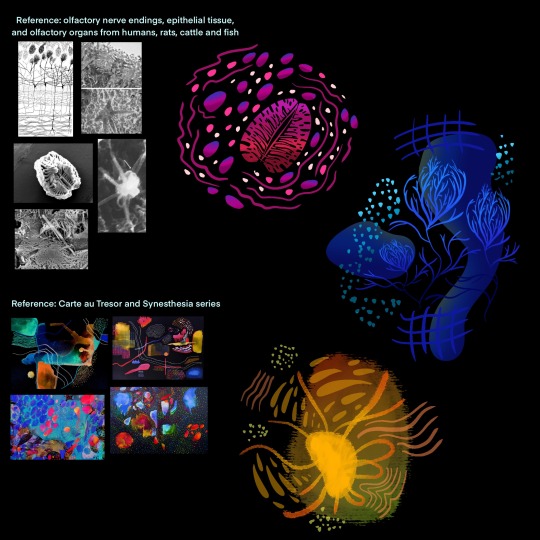
0 notes
Text
Lecture notes: Reference and Reproduction courtesy of artist Jesse Hogan (28.2.23)
There is an overlapping conversation between historical and contemporary artists/artworks in referencing material/thematic ideas.
This creates a philosophical interrogation of how the image (and its creation/display) is perceived, which Hogan examines.
Jean Baudrillard, in his ‘Simulation and Simulacrum’ (1981), argues that we exist in a representation of reality, with reality itself replaced by representations/imitations (“signs”) of reality (which might explain why some see this work as an endless source of existentialism).
In the paintings of his ‘Floor Talks and Installs’ series (2009-2016), Hogan explores the relationships between the artist and the aesthetic of the original art installations, while recontextualising the conceptual function of painting.
Therefore, the almost photographic/archival documentation of these paintings exist in a “post-painting territory”.
Emerging art embraces the impermanent nature of artistic practice.
Thus, ‘derivative works’ generate a continuous conversations of thematic and material practice beyond mere imitation/repetition (this is why recontextualisation is so important, but again it’s only one way to do it).
0 notes